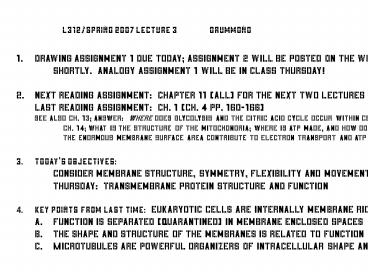L312Spring 2007Lecture 3Drummond - PowerPoint PPT Presentation
1 / 18
Title:
L312Spring 2007Lecture 3Drummond
Description:
Analogy assignment 1 will be in class Thursday! ... Oleic acid (9-10 cis) Compare three common lipids. Which elements are charged? Polar? ... – PowerPoint PPT presentation
Number of Views:52
Avg rating:3.0/5.0
Title: L312Spring 2007Lecture 3Drummond
1
L312/Spring 2007 Lecture 3 Drummond
- 1. Drawing assignment 1 due today assignment 2
will be posted on the website - shortly. Analogy assignment 1 will be in class
Thursday! - Next reading assignment Chapter 11 (all) for
the next two lectures - Last reading assignment Ch. 1 (Ch. 4 pp.
160-166) - See also Ch. 13 answer where does glycolysis
and the citric acid cycle occur within cells? - Ch. 14 what is the structure of the
mitochondria where is ATP made, and how does - the enormous membrane surface area
contribute to electron transport and ATP
synthesis? - 3. Todays objectives
- consider membrane structure, symmetry,
flexibility and movement - Thursday transmembrane protein structure and
function - Key points from last time Eukaryotic cells are
internally membrane rich - function is separated (quarantined) in membrane
enclosed spaces - The shape and structure of the membranes is
related to function - Microtubules are powerful organizers of
intracellular shape and function
2
For these features, note subject, scale and
context where do shapes come from? How do
materials move?
3
What are the essential roles of membranes within
cells?
(no physical transport)
Flexibility (are all membranes basically the
same?)
(highly selective physical transport)
What else? (see Fig. 11-1)
4
What gives membranes structure--and what is the
cell-free state?
5
The structure with the minimal surface area is
the lowest energy state
6
Phospholipids can spontaneously form liposomes
How do these compare to the size of a cell? How
well do you predict materials to exchange across
the membranes? What could they be used for
(medically/scientifically)
7
How does the plasma membrane structure compare
with natural liposomes?
Break to movie is the membrane a dynamic
structure?
8
What gives cells or organelles their specific
shape?
Or what supports thin, fragile membranes?
9
The cell cortex in red blood cells
vs. membrane thickness 5 nm
10
What is the basic structural element of the
phospholipid bilayer?
Phosphatidyl choline serine ethanolamine inositol
Stearic acid (C18 linear) Oleic acid (9-10 cis)
What do these terms mean? What is the
kink? What structure is in red/pink?
11
Compare three common lipids Which elements are
charged? Polar? Hydrophobic, and therefore in the
membrane?
12
Look closely at where the charged and polar
residues lie what is the overall charge of each
head group
Why do double bonds in the membrane increase
fluidity?
13
Why does cholesterol lend rigidity to the
membrane?
14
The lipid bilayer is asymmetric specific lipids
populate each sheath
15
Examples of lipid asymmetry in the membrane
Phosphatidyl serine (negative overall),
ethanolamine are heavily favored in the inner
leaflet.
16
The extracellular surface is coated with
carbohydrates
Note that these are linked to both lipids and
proteins. How did they get outside the cell?
17
If flip-flop is slow (how slow?), how rapid is
lateral diffusion?
Ask about lipids AND proteins
18
(No Transcript)































